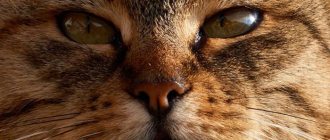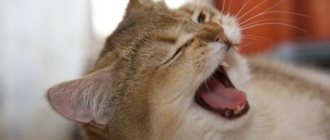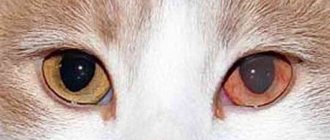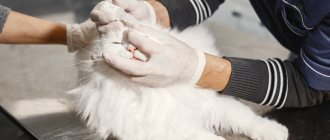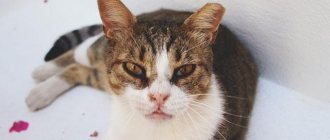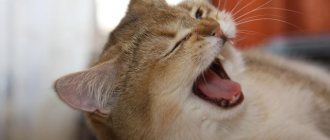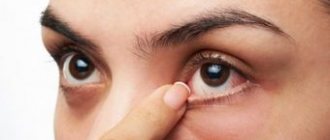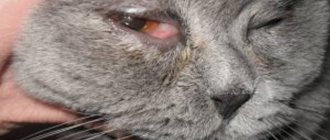Alas, pets are not only happiness, but also a great responsibility, since it is people who determine how long and carefree a pet will live. He cannot talk about his poor health, so the task of a responsible owner is to ensure that the kitten is well-groomed, fed, and feels good. It is important to pay attention to external signs of disease.
The article will tell you why a cat’s eyes are half covered with a film, what are the causes of the disease and methods of its treatment.
Short description
Unfortunately, a disease in which part of a cat's eyelid is covered with a white, opaque film is common. The film bears the name of the third century and is of great importance. It removes foreign particles and dust, and also distributes tear fluid. The third eyelid (conjunctival fold or nictitating membrane) is located at the inner corner of the eye. It is almost impossible to notice it in a healthy animal. If the cat is sick, the membrane becomes inflamed and turns white.
Keratitis
Keratitis is a lesion of the cornea of the eye. It can be caused by either trauma, including foreign body impact, or infection. The main symptoms of keratitis are:
- photophobia;
- profuse lacrimation;
- corneal clouding;
- accumulation of discharge in the corner of the eye.
When treating keratitis, it is important to exclude the possibility of its relapse : eliminate the cause of the disease. Effective drug intervention is impossible without the help of a veterinarian. Only a specialist can correctly determine the cause of the disease and prescribe the correct therapy.
Main reasons
The reasons for the appearance of a white film on a cat’s eyes can be varied:
- eye diseases such as conjunctivitis;
- mechanical impact;
- getting foreign objects into the eyes;
- parasites (internal and external);
- neoplasms (adenomas);
- allergy.
Let's look at some of them in more detail.
Infection
The action of the main contagion is combined with the influence of secondary microflora:
- rhinotracheitis;
- calcivirosis;
- panleukopenia;
- chlamydia.
Congenital anomalies
It is believed that some cat breeds are genetically predisposed to eye diseases. At risk, for example, are Persian cats and other brachycephalic breeds.
Invasion
Eye inflammation is caused by the following pathogens:
- protozoa;
- toxoplasmosis;
- helminthiases.
Permanent pathologies
These include pathologies such as hepatitis, pancreatitis, diabetes mellitus and other chronic diseases. They weaken the immune system, making the cat defenseless against the microflora that causes conjunctiva.
Hypersensitivity
Plant pollen, perfumes and accessories can be irritants in the formation of conjunctivitis, which is accompanied by the appearance of a transparent film on the cat's eye.
Why do cats close their eyes when they eat?
When cats eat, they are relaxed and close their eyes because they are enjoying the food. This is also true when they eat their favorite treats. The tastier and more aromatic they are, the more often cats close their eyes.
Cats also close their eyes to protect themselves when eating. While wet food or dry food aren't likely to create too much of a mess, feral cats tear meat from bones with their razor-sharp teeth.
As a result, there is a risk that pieces of meat and bones may get into their eyes, damaging them and impairing their function.
Likewise, flies are a problem in warm regions. They are attracted to dead flesh and will take any opportunity to feed on it. To prevent flies from getting into their eyes, cats close them.
On the other hand, kittens close their eyes to feed from their mother. This is because they have not opened completely. After 8-12 days, their eyes begin to open naturally and they begin to see.
External manifestation
Third eyelid disease can be diagnosed not only by changes in the pet’s appearance, but also by changes in behavior. Most likely, the cat is hiding from bright lighting, rubbing its face with its paws, and especially its eyes, blinking and squinting frequently due to noticeable discomfort. You can also see profuse lacrimation and even the presence of pus. If treatment is not carried out in time and you do not consult a veterinarian, there is a high probability of vision loss.
You can also notice the third eyelid by the presence of the following inflammations:
- adenoma;
- cartilage malformations;
- protrusion of the nictitating membrane.
Adenoma
This is a pink tumor that is located near the bridge of the nose. It is benign and resembles a bean in shape. The main causes are injury or infection. It is easy to detect; the eye stops closing. If not treated promptly, serious complications can occur.
Cartilage malformations
Defective cartilage is deformed during the growth phase, as a result of which the nictitating film begins to become inflamed. It is one of the congenital anomalies.
Protrusion of the nictitating membrane
If the third eyelid appears in only one eye, the causes of the pathology may be as follows:
- foreign objects under the film;
- injuries to the facial nerves, cornea or cartilage;
- accretion of the membrane to the eyeball.
If the third eyelid appears in both eyes, the following reasons for its occurrence are distinguished:
- infectious conjunctivitis;
- helminthiases.
Why do cats close their eyes when they sleep?
Cats sleep for approximately 12-16 hours and fall asleep very quickly. Since they are most active at night, they sleep all day to conserve their energy, which prepares them for nighttime wandering and hunting.
The first reason why cats close their eyes while sleeping is that it gives them the darkness they need to sleep when there is light during the day. Some cats hide under beds in the dark, but felines that enjoy being close to their owners cover their eyes with their legs.
© shutterstock
Cats also go through two main stages of sleep. The first is rapid eye movement (REM). According to the US National Library of Medicine, rapid eye movements are accompanied by loss of muscle tone, muscle twitching and wakefulness-like cortical activity.
During this stage of sleep, the cat's brain reflects its activity while it is awake. This is also the time when cats dream most often. As a result, cats close their eyes at this stage because their muscles are too relaxed to keep them open.
Another stage of sleep is non-rapid eye movement (NREM) sleep. This is the deepest stage of sleep for a cat, allowing it to recover its body after a night of wandering and hunting.
Cats in NREM are vulnerable. In the wild, this is the time when predators are most likely to attack. At home, cats hide in a safe shelter. Finding shelter allows them to stay safe and sleep without fear.
Diagnostics
If you see that your cat's eyes are covered with a film, we advise you to contact a veterinarian as soon as possible. Timely treatment will help quickly restore vision and avoid re-infection.
A specialist doctor uses an ophthalmoscope to determine the cause of the underlying pathology of the eye disease and propose an effective course of treatment. In some cases, surgery may be required.
It is imperative to monitor the dynamics of the disease.
Why do cats close their eyes when you pet them?
Most cats love to be petted by their owners. It brings them pleasure and calms them down. Touch is also a means of communication between cats and their owners. Cats don't naturally trust animals. People have to earn it. As a result, when cats close their eyes when being petted, it is because they trust you.
Cats prefer to remain vigilant, keep their eyes open and their instincts sharp. This is done so that they can avoid danger. When they close their eyes, they know you pose no risk and mean no harm.
According to Live Science, cats like to feel around the base of their ears, under their chin, and around their cheeks. This is where their sensitive facial glands are located. When cats enjoy petting, they close their eyes and show the following signs:
- Vertical tail
- Purr
- Kneading with front paws
- Relaxed pose
- Ears facing forward
- Push your head
However, keep in mind that cats do not always enjoy being stroked on their bellies, backs, and the base of their tails. Signs of petting stress include:
- Whistling Tail
- Ears flattened to the sides
- Ears rotate backwards
- Skin twitching
- Sudden turn of head
- Exaggerated flashing
- Nose licking
- Clapping or waving a paw
- Wide eyes and pupils
If you notice any of the above signs, try petting a different area on your cat's body and avoid those sensitive areas.
© shutterstock
Treatment
To treat this type of disease, veterinarians offer several methods:
- drops or ointments with an anesthetic effect - they help relieve inflammation;
- inclusion of vitamins B12 in the cat’s diet;
- balanced diet;
- washing the eyes using olive oil, warm tea, boric acid or just warm water.
The simplest method, but no less effective, is considered to be preventive eye rinsing. This procedure makes it possible to remove dust and foreign particles from the eyes.
How to wash your eyes
The rinsing procedure is required periodically when the eyes become watery, suppuration appears, or a film forms. Before starting, you should wash your hands thoroughly with soap to avoid further infection. It is better to rinse with an assistant: one person fixes the pet, the second acts, this way the process will go faster.
You need to use a special solution to wash your eyes. Rinsing is carried out as follows: thoroughly moisten a cotton swab in the solution and then carefully rinse both eyes of the animal. After completing the procedure, be sure to blot your eyes with a dry cotton pad.
When is a visit to a veterinary ophthalmologist necessary?
Cat owners should be attentive to their pets and if the following signs appear, show them to an ophthalmologist:
- Swelling and redness of the eyelids.
- The animal constantly scratches its eyes.
- The cat developed photophobia.
- Redness of the eyes.
- Increased tear production.
- Cloudy, purulent discharge from the eyes.
Important!
Do not delay your visit; untimely treatment can lead to partial or complete loss of vision.
Prevention measures
The most effective way of therapy is to prevent the problem.
To prevent inflammation of the third eyelid in a cat, use the following recommendations:
- Create a balanced cat diet from quality products.
- Be sure to add vitamins to your food.
- Periodically carry out eye rinsing procedures.
- Monitor your pet for changes in behavior and examine its eyes regularly.
- Visit a veterinarian at least once a year.
Remember, the sooner you detect eye disease in a cat, the greater the likelihood of its speedy cure. You should not self-medicate; you should immediately take the animal to the veterinarian.
Why do cats close their eyes when they sit?
Cats close their eyes when they sit because they are in a state of relaxation. Cats who are comfortable in the presence of their owners are happy to relax with their eyes closed because they know they are safe.
They are also likely to be in slow wave sleep (SWS), which is the most superficial form of rest. This stage of sleep usually precedes the rapid eye movement stage of sleep, which is much deeper.
However, these stages of sleep are important for conserving the large amounts of energy cats need to hunt, play, and roam.
During slow-wave sleep, cats lie with their heads raised and paws tucked. Sometimes they also sleep sitting up, their muscles tense to keep them upright and still.
Although cats look like they are sleeping with their eyes closed, they are fully aware of what is happening around them. As a result, you will see their ears rotate back and forth as they hear sounds in their environment.
This alertness allows them to attack or flee when they need to react to danger. Cats exhibit this sleep behavior several times during the day, especially when it's cold and rainy outside and they have nothing else to do.
© shutterstock
Diseases of the nervous system accompanied by prolapse of the third eyelid
If prolapse of the third eyelid is accompanied by a narrowing of the pupil of the same eye, drooping of the upper eyelid, and an apparent decrease in the size of the eyeball, this is a reason to show the cat to a neurologist as soon as possible, since the complex of these symptoms (Horner syndrome) often indicates damage to the nervous system. The reasons for such a lesion may be different; in some cases, in addition to a neurological examination and routine tests, additional diagnostics are necessary - CT, MRI, and some others.
Corneal ulcer
This is an inflammation of the cornea, accompanied by its defect.
Symptoms:
- Squinting (blepharospasm)
- Watery or purulent discharge, pain.
— You may notice a roughness, indentation, or whitish spot on the surface of the cornea.
Treatment:
Depending on the severity of the process:
1. Medication (antibiotics, keratoprotectors, etc.)
2. Surgical.
============================================================================================================================================================================================
